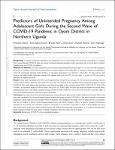| dc.contributor.author | Okalo, Ponsiano | |
| dc.contributor.author | Arach, Anna Agnes | |
| dc.contributor.author | Apili, Brenda | |
| dc.contributor.author | Oyat, Jimmy | |
| dc.contributor.author | Halima, Namata | |
| dc.contributor.author | Kabunga, Amir | |
| dc.date.accessioned | 2023-02-06T12:42:30Z | |
| dc.date.available | 2023-02-06T12:42:30Z | |
| dc.date.issued | 2023 | |
| dc.identifier.citation | Okalo, P., Arach, A. A., Apili, B., Oyat, J., Halima, N., & Kabunga, A. (2023). Predictors of Unintended Pregnancy Among Adolescent Girls During the Second Wave of COVID-19 Pandemic in Oyam District in Northern Uganda. Open Access Journal of Contraception, Volume 14, 15–21. | en_US |
| dc.identifier.uri | https://doi.org/10.2147/OAJC.S399973 | |
| dc.identifier.uri | http://ir.lirauni.ac.ug/xmlui/handle/123456789/494 | |
| dc.description.abstract | Background: In Uganda, unintended pregnancies are responsible for one in three births with detrimental consequences, a situation
that worsened during COVID-19. Thus, the present examined unplanned pregnancy and its associated risks in Oyam district, northern
Uganda during the COVID-19 epidemic.
Methods and Methods: This study employed a cross-sectional study among adolescent girls aged 15–19 years who had a pregnancy
during the second phase of COVID-19 in Oyam district, northern Uganda in November 2022. A consecutive method was employed to
recruit the participants attending health facilities. A structured questionnaire was utilized to collect data. For data analysis, both
bivariate and multivariable regression methods with adjusted odds ratio and 95% CI were used. A p-value of 0.05 was used to
determine the significance level.
Results: Of the total respondents, 292 (69.5%) were aged between 18 and 19 years of age, 295 (70.2%) lived in rural areas, and 222
(52.9%) had no formal education. The results also show that 293 (69.8%) of the respondents had unintended pregnancies during
COVID-19. The results indicate that participants who lacked knowledge of the ovulation period (AOR: 0.242; 95% CI: 0156–0376;
P<0.001), sex education during COVID-19 (AOR: 0.563; 95% CI:: 0.365–0.869; P=0.024) and lacked the freedom to discuss family
planning-related issues with family members during COVID-19 (AOR: 0.228; 95% CI: 0.138–0.376; P<0.001) were more likely to
have an unintended pregnancy compared to their counterparts.
Conclusion: Our study shows that unwanted pregnancies among adolescent girls remain a public health issue in Oyam district with
more than two-thirds of adolescents having unwanted pregnancies during the crisis of COVID-19. The major correlates of unwanted
pregnancies among adolescent girls during COVID-19 pandemic were inadequate knowledge of the ovulation period, sex education,
and lack of freedom to discuss family planning-related issues with family members. There is a need to prioritize interventions,
especially in rural settings. Sex education to improve contraceptive use and delay sexual debut. In light of the possibility that social
and cultural norms in the Oyam district prohibit parents and children from discussing sexual subjects, it is crucial to promote sexual
health education through the mass media, including newspapers, television, radio, and social media.
Keywords: adolescents, COVID-19, crisis, unintended pregnancy | en_US |
| dc.language.iso | en | en_US |
| dc.publisher | Open Access Journal of Contraception | en_US |
| dc.subject | adolescents, COVID-19, crisis, unintended pregnancy | en_US |
| dc.title | Predictors of Unintended Pregnancy Among Adolescent Girls During the Second Wave of COVID-19 Pandemic in Oyam District in Northern Uganda | en_US |
| dc.type | Article | en_US |

